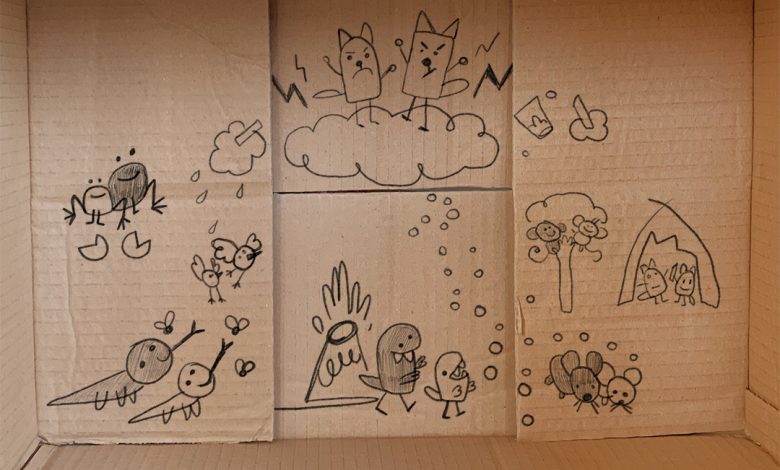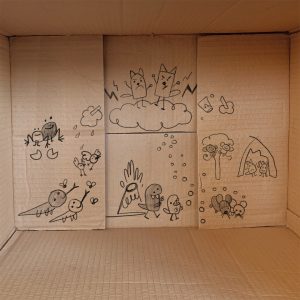FROGS AND LIZARDS AND CAVE DOGS, OH MY!
Bluey’s “Flat Pack” belongs to a long line of art made about the human spirit

Lila Alonso Limongi ’26 / Emertainment Monthly Staff Writer
Spoilers ahead.
Richard Strauss’ “Also sprach Zarathustra” blasts in your ear drums, as the proto-human takes the bone off a carcass and raises it above their head. They slam it down. Once, twice, and then compulsively over the skeleton of a dead animal. Although the proto-human cannot grin, in their hitting of the corpse, then of a live animal and of another proto-human, there is a strange kind of glee. The Strauss continues to blare.
This iconic opening scene from 2001: A Space Odyssey (Kubrick 1968) was not the first piece of media to thematize the evolution of humankind. It was also certainly not the last. A seven-minute episode of Bluey (2018), an Australian children’s cartoon, has recently joined that roster. The episode, entitled “Flat Pack”, was released only recently, in March of 2022. And, to put it simply, it is children’s television at its finest.
Bluey is an innocent little show that hides, in the midst of its incredibly large seasons, bite-sized episodes that can bring college-aged adults to tears. It discusses family relationships, focusing on a multi-colored family of dogs composed by Mum (Melanie Zanetti), Dad (David McCormack) and two young daughters, Bingo and Bluey (uncredited actors), as they play together.
“Flat Pack” is no exception to the themes of Bluey. It splits the family into A and B plots, which take place feet away from each other. While Mum and Dad are busy trying to assemble an Ikea-style–or “flat pack”, in Australian–swinging chair on the house’s deck, Bingo and Bluey are playing on the lawn. As Mum and Dad struggle to build the furniture, their daughters play with the pieces they leave behind. Bubble wrap becomes the ocean, a folded piece of floppy cardboard becomes a volcano, and a big ball of styrofoam becomes snow.
Bingo and Bluey’s experience of playing together is enough to make anyone missing their childhood feel a little tug at the pit of their stomach. “Pretend we’re fish!” (Jeffery 2018) exclaims Bluey, after the sisters decide that the bubble wrap will be the ocean. Bingo immediately agrees, adding that she would like to be the “baby fish” (Jeffery 2018), while Bluey takes up the role of the mom. That exchange is familiar, realistic. It’s a testament to the writers’ ease with representing the childhood experience, as well as their appreciation of children’s unrestrained use of their imaginations.
This appears clearly in Bingo’s, the youngest daughter, growing up as play time continues. Her role beings as a “baby” to Bluey’s “mum”, but, and she continues to remind her sister of this, she quickly leaves this age. Soon, she’s a “toddler”, and then a “teenager”. This is, after all, a common move in any playground–and one that keen eyes of the writers haven’t failed to notice.
But, the most special part of the episode is how Bingo and Bluey’s playtime is framed. They begin as fish, then decide to become frogs, then lizards–following the timeline of Charles Darwin’s theory of evolution. Eventually, they become monkeys, playing on a tree, and finally, “cave dogs”. Processes of construction, therefore, are paralleled. As Mum and Dad build something for the family, so too do their daughters build. In this case, however, they are constructing the process of evolution that led to the existence of the human race. The parallel somehow fits perfectly in the bite-sized episode, another testament to the writers’ skill.
As Bingo and Bluey become “cave dogs”, they move into a giant cardboard box, where Bluey redraws the process of evolution in black marker–a cave painting. Communicating in onomatopoeias, the oldest instructs Bingo on what they have been through, explaining how the existence of those animals resulted in them–Bluey points at herself and then at Bingo, indicating the final drawing in her work of art. It shows both of them, up in the clouds, towering over evolution. It’s a beautiful moment, showcasing humanity’s track to becoming what it is today, and how every single human being–even Bingo and Bluey who, admittedly, are dogs–belong to a huge, sprawling process of change. [Image 1] As Mum and Dad throw their final materials into the lawn, Bingo and Bluey evolve even further. “Let’s pretend we’re builders!”, they decide (Jeffery 2018).
This moment is particularly touching. Bluey makes a sweet point–that throughout its evolution, humanity has created many beautiful things. Although destruction has been rampant, humans are builders, first of all. They love to create. And as Mum and Dad watch over their daughters, they stop squabbling over the furniture for a moment to say, fondly: “We made them” (Jeffery 2018), reflecting once more on the human need to make – be it shaping people or things, humanity is always searching for a project. Bingo and Bluey give into that impulse and make their city, expressing one of the most fundamental aspects of human nature: the need to create.
Bingo approaches Bluey with a cardboard box around her waist. “Mum,” she says. “I built a spaceship to go and explore space.” There’s that desire to create again, now joined by another essential human quirk: the need to explore. Bingo and Bluey hug goodbye, and they have a heart-warming exchange: “Thanks for looking after me”, says Bingo. “That’s okay,” replies Bluey, with a smile (Jeffery 2018). Many young adults recognize this moment: it’s the parting at the door of the dorm room when your parents drop you off for the first time. It’s the first time you realize how much your parents have done for you. “We mothers stand still,” says Ruth Handler (Rhea Perlman), in the final moments of the Barbie movie, “so our daughters can look back to see how far they’ve come.”(Gerwig 2023) The quote rings out as Bluey looks out at Bingo “flying away” and says, “What am I going to do now?” (Jeffery 2018).
It’s then that Mum and Dad have finally finished putting their chair together. Mum calls Bluey’s attention, and pulls her up to the porch. At the moment their hands–paws–touch, the frame holds for a moment, and the sun shines behind them. It’s God reaching out to Adam in the Sistine Chapel paintings. Dad comments wistfully, “This is heaven”, as he, Mum and Bluey sit on the chair they built, looking out at Bingo as she plays happily on the lawn (Jeffery 2018).
In Becky Chambers’ Psalm for the Wild Built, the robot Mosscap asks Sibling Dex, a conflicted monk: “Do you not find consciousness alone to be the most exhilarating thing? […] You and I–we’re just atoms that arranged themselves the right way, and we can understand that about ourselves. Is that not amazing?” (Chambers 2021). The book is one of the many pieces of media that has attempted to portray this feeling of “heaven”. It’s the feeling humans get when they see other people being… people: When you walk past a group of friends laughing together, or when you watch surreptitiously as that old couple feeds the pigeons for no other reason besides loving their little coos.
The consciousness to understand these delicate moments is a gift, a gift Bluey explores in its weaving of evolution, growing up, creation and discovery. With “Flat Pack”, the show has inscribed itself into the canon of art that celebrates the human spirit–which includes works such as Michelangelo’s Sistine Chapel paintings, and Stanley Kubirck’s 2001. Bluey‘s simple, yet direct, approach to these complicated topics cement it as an excellent addition, not at all diminished by the show’s target audience. In fact, opening children up to this optimistic view of humanity is a noble way to go, and Bluey has thread that path perfectly.

Bluey’s educational drawings show her and Bingo’s journey through evolution.